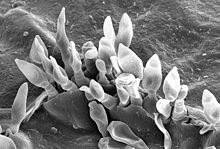
They Don't Live Alone
Malus domestica has many interactions with other organisms,
some beneficial and some not so beneficial. This includes
bacteria, fungi, insects, worms and mammals.
Bacteria are used by Malus domestica by means of nitrogen
fixation. Many species of bacteria are capable of making
useable nitrogen for organisms, like Malus domestica. When
the nitrogen is collected in the form of ammonia, the apple tree
in return will give off carbohydrates for the bacteria.
This is called a mutualistic interaction because both organisms
are benefitted.
Fungi also interact with apples. In a mutualistic way,
fungi from the phylum Glomeromycota form endomycorrhizae.
These fungi reside on the outside and outer layer of the roots.
From here, the fungi help in the absorption of water. They
also help absorb nutrients, like phosphorous and potassium.
As a token of gratitude, the fungi are given a food source in
the form of carbohydrates/sugars.

Fungi can also not be so friendly. Venturia inaequalis is
the fungi responsible for the disease known as
apple scab.
This disease creates brownish-black spots on the leaves and
fruit of apples. This fungi causes the leaves to curl and
shrivel and causes the fruit to become misshapen and
cracked. The disease often times will cause apples to fall
before they are fully developed. This is called a
parasitic interaction because the fungi are harming the plant.
Insects have both mutualistic and parasitic interactions with
the apple. The main pollinators of Malus domestica
are insects, like bees . This is a mutualistic
relationship that helps the plant reproduce and gives the insect
food in the form of nectar. There are many insects that
are parasitic to the apple. Parasitic insects include
aphids, moths, maggots, and mites. Fruitworms and other
worms can also be parasitic to apples.
Malus domestica
are insects, like bees . This is a mutualistic
relationship that helps the plant reproduce and gives the insect
food in the form of nectar. There are many insects that
are parasitic to the apple. Parasitic insects include
aphids, moths, maggots, and mites. Fruitworms and other
worms can also be parasitic to apples.
 Many mammals
like the
white-tailed deer,
moose, and
horse eat apples as a source of energy, including humans.
Humans grow apples in orchards all around the world to use as
food (see Habitat and Geography). Although mammals are
eating the organism, it is actually a mutualistic interaction.
When mammals eat apple seeds, they are eventually defecated and
relocated. This helps apple trees transport their seeds to
other possible growing areas.
Many mammals
like the
white-tailed deer,
moose, and
horse eat apples as a source of energy, including humans.
Humans grow apples in orchards all around the world to use as
food (see Habitat and Geography). Although mammals are
eating the organism, it is actually a mutualistic interaction.
When mammals eat apple seeds, they are eventually defecated and
relocated. This helps apple trees transport their seeds to
other possible growing areas.
